Energy Consumption Prediction for Solar Greenhouse Based on Whale Optimization Extreme Learning Machine: Integration of Heat Balance Model and Intelligent Algorithm
Abstract
1. Introduction
2. Materials and Methods
2.1. Experimental Greenhouse
2.2. Experimental Method
Distribution of Test Instruments and Measurement Points
2.3. Energy Consumption Prediction Model Construction Method
3. Construction of the Prediction Model
3.1. Model Building
3.2. Sensitivity Analysis
4. Construction of the Prediction Model
4.1. Extreme Learning Machine
4.2. Principles of Whale Optimization Algorithm
- (1)
- Surrounding the prey
- (2)
- Spiral bubble mesh hunting
- (3)
- Random search
4.3. WOA-ELM Model
- (1)
- Determine the number of nodes in the Extreme Learning Machine network and the parameters to be optimized;
- (2)
- Initialize the WOA population and randomly generate a set of whale locations, each representing a combination of parameters for the ELM. These positions will be used for subsequent parameter optimization;
- (3)
- Training ELM for fitness assessment: For each whale location (i.e., each set of ELM parameters), the ELM model is trained using the training data. To evaluate the performance of the ELM model, metrics such as classification accuracy and mean square error are usually used to calculate the fitness;
- (4)
- Update the position of the whale according to the rules of the Whale Optimization Algorithm;
- (5)
- Determine whether the maximum number of iterations is reached, if not, repeat the whale position optimization, if the maximum number of iterations is reached, proceed to the next step;
- (6)
- The found optimal weights and thresholds are output to the ELM model, and then the greenhouse energy consumption prediction is performed.
4.4. Evaluation Indicators
5. Results and Analysis
5.1. Model Parameter Setting
5.2. Analysis of Model Prediction Results
6. Discussion
- (1)
- To address the issues of high energy consumption in solar greenhouses and the difficulty of achieving optimal selection of hyperparameters in a single Extreme Learning Machine (ELM), this study introduced the Whale Optimization Algorithm (WOA), an intelligent algorithm, to optimize the parameters of ELM for improved prediction accuracy. By optimizing weights and thresholds, the impact of randomness in parameter selection was reduced, making the model more consistent and stable across different runs. A comparative analysis of the prediction performance of the WOA-ELM network model with Artificial Neural Network (ANN), Radial Basis Function (RBF) neural network, and ELM model revealed differences in model errors under varying weather conditions. On cloudy days, solar radiation is negligible, and the thermal load is almost entirely borne by the heat fan. Energy consumption is mainly driven by the indoor-outdoor temperature difference, showing an approximate linear relationship that is easily identifiable by each model, resulting in overall lower errors. On sunny days, solar radiation increases sharply, leading to a strong coupled nonlinear relationship among solar radiation energy, indoor ventilation heat loss, and crop latent heat. Indoor ventilation heat loss is highly sensitive to skylight opening, wind speed, and transpiration latent heat, resulting in generally higher model errors on sunny days. Error comparison results indicate that under different weather conditions, the WOA-ELM network model exhibits higher prediction accuracy in terms of both fitting degree and the error between predicted and actual values. It can better capture nonlinear transient changes in the greenhouse, further demonstrating its robustness and accuracy advantages in complex light-temperature environments. This model provides an accurate method for greenhouse energy consumption prediction, management, and control, with significant practical significance and value.
- (2)
- Solar greenhouses in the northern slope of the Tianshan Mountains in Xinjiang require substantial heat supplementation for safe overwintering production, leading to increased energy consumption and production costs. The model constructed in this study provides a scientific basis for the design of winter heating systems. Based on this model, an optimized heating control strategy can be proposed: using sensors and controllers to real-time monitor parameters such as temperature, humidity, and light inside and outside the greenhouse, and automatically controlling the switch and power of heating equipment according to preset control strategies. This approach enables precise temperature control, reducing energy consumption and costs to a certain extent.
- (3)
- The currently constructed WOA-ELM solar greenhouse energy consumption prediction model achieves high-precision prediction under sunny and cloudy conditions and clarifies the sources of errors, but it still has limitations. The samples only cover the tomato fruiting stage, failing to consider the impact of changes in leaf area index and canopy heat transfer coefficient during the seedling and flowering stages on the heat balance, which may increase the prediction error of the model by 15–20% during other growth stages. Additionally, the model’s adaptability to extreme weather conditions such as cold waves and heavy snow remains unvalidated, and such weather may increase the model’s RMSE to above 0.6. Future research can improve the model by incorporating a dynamic parameter module for crop growth stages, constructing specialized sub-models for extreme weather, and adjusting the weights of heat transfer and heat dissipation terms in the heat balance equation.
7. Conclusions
- (1)
- Under cloudy conditions, the root mean square errors (RMSEs) of the WOA-ELM, BP, RBF, and ELM models are 0.423, 0.585, 0.63, and 0.575, respectively; the mean absolute errors (MAEs) are 0.252, 0.444, 0.504, and 0.348, respectively; and the coefficients of determination (R2) are 0.93, 0.85, 0.85, and 0.88, respectively. Under sunny conditions, the RMSE values of the above four models are 0.27, 0.705, 0.726, and 0.639, respectively; the MAE values are 0.063, 0.477, 0.453, and 0.339, respectively; and the R2 values are 0.96, 0.89, 0.88, and 0.91, respectively. The ranking of the prediction performance of the four models from best to worst is WOA-ELM > ELM > BP > RBF.
- (2)
- By integrating the mechanistic analysis of the physical model and the parameter optimization of the intelligent algorithm, the WOA-ELM model achieves higher prediction accuracy under different weather conditions, verifying its effectiveness in solar greenhouse energy consumption prediction.
- (3)
- The model provides a theoretical basis for the energy load design, management, and control of steel-frame solar greenhouses without back slopes in the northern slope of the Tianshan Mountains in Xinjiang. Based on its prediction results, the operation strategies of greenhouse heating, ventilation, and irrigation equipment can be dynamically adjusted to minimize energy consumption and reduce production costs while ensuring crop growth. Additionally, the WOA-ELM model can be used for long-term trend analysis of greenhouse energy consumption, providing data support for greenhouse design and energy planning.
Author Contributions
Funding
Institutional Review Board Statement
Informed Consent Statement
Data Availability Statement
Conflicts of Interest
References
- Hassanien, R.H.E.; Li, M.; Lin, W.D. Advanced applications of solar energy in agricultural greenhouses. Renew. Sustain. Energy Rev. 2016, 54, 989–1001. [Google Scholar] [CrossRef]
- Zhu, C.; He, Q.; Zhao, Z.; Liu, X.; Pu, Z. Comparative Analysis of Ozone Pollution Characteristics between Urban Area and Southern Mountainous Area of Urumqi, China. Atmosphere 2023, 14, 1387. [Google Scholar] [CrossRef]
- Kaneda, Y.; Ibayashi, H.; Oishi, N.; Mineno, H. Greenhouse environmental control system based on SW-SVR. Procedia Comput. Sci. 2015, 60, 860–869. [Google Scholar] [CrossRef]
- Cunha, J.B.; Couto, C.; Ruano, A.E.B. Real-time parameter estimation of dynamic temperature models for greenhouse environmental control. Control Eng. Pract. 1997, 5, 1473–1481. [Google Scholar] [CrossRef]
- Li, S.J.; Wu, L.X.; Wang, Y.T.; Geng, T.; Cai, W.J.; Gan, B.L.; Jing, Z.; Yang, Y. Intensified Atlantic multidecadal variability in a warming climate. Nat. Clim. Change 2025, 15, 1–8. [Google Scholar] [CrossRef]
- Jolliet, O.; Danloy, L.; Gay, J.-B.; Munday, G.; Reist, A. HORTICERN: An improved static model for predicting the energy consumption of a greenhouse. Agric. For. Meteorol. 1991, 55, 265–294. [Google Scholar] [CrossRef]
- Singh, R.D.; Tiwari, G.N. Energy conservation in the greenhouse system: A steady state analysis. Energy 2010, 35, 2367–2373. [Google Scholar] [CrossRef]
- Ahamed, M.S.; Guo, H.; Tanino, K. Development of a thermal model for simulation of supplemental heating requirements in Chinese-style solar greenhouses. Comput. Electron. Agric. 2018, 150, 235–244. [Google Scholar] [CrossRef]
- Dai, J.; Luo, W.; Li, Y. A microclimate model-based energy consumption prediction system for greenhouse heating. Sci. Agric. Sin. 2006, 11, 21. [Google Scholar]
- Xu, F.; Zhang, L.B.; Chen, J.L.; Zhan, H.W. Modeling and simulation of subtropical greenhouse microclimate in China. Nongye Jixie Xuebao = Trans. Chin. Soc. Agric. Mach. 2005, 36, 102–105. [Google Scholar]
- Shen, Y.; Wei, R.; Xu, L. Energy consumption prediction of a greenhouse and optimization of daily average temperature. Energies 2018, 11, 65. [Google Scholar] [CrossRef]
- Wang, X. Simulation of Microclimate and Energy Consumption Prediction in Modern Greenhouses in Southern China; Nanjing Agricultural University: Nanjing, China, 2003. [Google Scholar]
- Dai, J.; Luo, W.; Li, Y.; Qiao, X.; Wang, C. Research on Greenhouse Energy Consumption Prediction System Based on Microclimate Model. Sci. Agric. Sin. 2006, 39, 6. [Google Scholar]
- Yao, Y.; Dai, J.; Luo, W.; Su, G. Simulation of Energy Consumption Distribution for Year-Round Cucumber Production in Multi-Span Greenhouses in China. Trans. Chin. Soc. Agric. Eng. 2011, 27, 273–279+395. [Google Scholar]
- Ho, L.; Jerves-Cobo, R.; Forio, M.A.E.; Mouton, A.; Nopens, I.; Goethals, P. Integrated mechanistic and data-driven modeling for risk assessment of greenhouse gas production in an urbanized river system. J. Environ. Manag. 2021, 294, 112999. [Google Scholar] [CrossRef]
- Li, Z.; Wang, P.; Zhang, J.; Mu, S. A strategy of improvingindoor air temperature prediction in HVAC system based onmultivariate transfer entropy. Build. Environ. 2022, 219, 109164. [Google Scholar] [CrossRef]
- Liu, R.; Li, M.; Guzmán, J.L.; Rodríguez, F. A fast and practical one-dimensional transient model for greenhouse temperature and humidity. Comput. Electron. Agric. 2021, 186, 106186. [Google Scholar] [CrossRef]
- Taki, M.; Ajabshirchi, Y. Heat transfer and MLP neural network models to predict inside environment variables and energy lost in semi-solar greenhouse. Energy Build. 2015, 110, 314–329. [Google Scholar] [CrossRef]
- Trejo-Perea, M.; Herrera-Ruiz, G.; Rios-Moreno, J.; Miranda, R.C.; Rivasaraiza, E. Greenhouse energy consumption prediction using neural networks models. Training 2009, 1, 2. [Google Scholar]
- De Zwart, H.F. Analzing Energy-Saving Options in Greenhouse Cultivation Using a Simuation Model. Ph.D. Dissertation, Agricutural University of Wageningen, Wageningen, The Netherlands, 1996. [Google Scholar]
- Khoshnevisan, B.; Rafiee, S.; Omid, M.; Yousefi, M.; Movahedi, M. Modeling of energy consumption and GHG (greenhouse gas) emissions in wheat production in Esfahan province of Iran using artificial neural networks. Energy 2013, 52, 333–338. [Google Scholar] [CrossRef]
- Özden, S.; Dursun, M.; Aksöz, A.; Saygın, A. Prediction and modelling of energy consumption on temperature control for greenhouses. Politek. Derg. 2019, 22, 213–217. [Google Scholar] [CrossRef]
- Chen, J.; Chen, J.; Yang, J.; Xu, F.; Shen, Z. Energy consumption prediction of semi-closed greenhouses based on self-accelerating genetic particle swarm optimization algorithm. Trans. Chin. Soc. Agric. Eng. 2015, 31, 186–193. [Google Scholar]
- Zhang, Y.; Lin, S.; Shen, J.; Chen, C.; Li, Z.; Xie, T. Energy consumption prediction model for multi-span greenhouses based on LSTM. Tianjin Agric. Sci. 2023, 29, 74–79. [Google Scholar]
- Zhang, Y.; Zhang, Y.; Cheng, R.; Wang, C. Prediction of heat release from the walls of solar greenhouses based on partial least squares regression. Jiangsu Agric. Sci. 2022, 50, 208–213. [Google Scholar]
- Zhang, G. Research on Greenhouse Adaptive Control System Based on T-S Fuzzy Neural Network; Taiyuan University of Technology: Taiyuan, China, 2019. [Google Scholar]
- Liu, H. Research on the Water Demand Law of Greenhouse Tomato and the Index of High-Quality and High-Efficiency Irrigation; Chinese Academy of Agricultural Sciences: Beijing, China, 2010. [Google Scholar]
- Liao, S.; Feng, C. Meta-ELM: ELM with ELM hidden nodes. Neurocomputing 2014, 128, 81–87. [Google Scholar] [CrossRef]
- Kumar, M.; Gouw, M.; Michael, S.; Sámano-Sánchez, H.; Pancsa, R.; Glavina, J.; Diakogianni, A.; Valverde, J.A.; Bukirova, D.; Čalyševa, J.; et al. ELM—The eukaryotic linear motif resource in 2020. Nucleic Acids Res. 2020, 48, D296–D306. [Google Scholar] [CrossRef]
- Lei, X.; Xu, X.; Zhou, S. Potato Yield Prediction Research Based on Improved Artificial Neural Networks Using Whale Optimization Algorithm. Potato Res. 2024, 68, 1717–1726. [Google Scholar] [CrossRef]
- Monteiro, D.K.; Miguel, L.F.F.; Zeni, G.; Becker, T.; de Andrade, G.S.; de Barros, R.R. Whale Optimization Algorithm for structural damage detection, localization, and quantification. Discov. Civ. Eng. 2024, 1, 98. [Google Scholar] [CrossRef]
- Mostafa Bozorgi, S.; Yazdani, S. IWOA: An improved whale optimization algorithm for optimization problems. J. Comput. Des. Eng. 2019, 6, 243–259. [Google Scholar] [CrossRef]
- Liu, Z.; Huang, X.; Wang, X. PM2.5 prediction based on modified whale optimization algorithm and support vector regression. Sci. Rep. 2024, 14, 23296. [Google Scholar] [CrossRef] [PubMed]
- Chen, W.; Hong, H.; Panahi, M.; Shahabi, H.; Wang, Y.; Shirzadi, A.; Pirasteh, S.; Alesheikh, A.A.; Khosravi, K.; Panahi, S.; et al. Spatial prediction of landslide susceptibility using gis-based data mining techniques of ANFIS with whale optimization algorithm (WOA) and grey wolf optimizer (GWO). Appl. Sci. 2019, 9, 3755. [Google Scholar] [CrossRef]
- Li, C.; Zhou, J.; Khandelwal, M.; Zhang, X.; Monjezi, M.; Qiu, Y. Six novel hybrid extreme learning machine–swarm intelligence optimization (ELM–SIO) models for predicting backbreak in open-pit blasting. Nat. Resour. Res. 2022, 31, 3017–3039. [Google Scholar] [CrossRef]
- Huang, G.B.; Wang, D.H.; Lan, Y. Extreme learning machines: A survey. Int. J. Mach. Learn. Cybern. 2011, 2, 107–122. [Google Scholar] [CrossRef]
- Zhou, W.; Xie, C.; Dong, Y.; Gao, Y.; Tang, Y. Comparative Testing and Analysis of Winter Microclimate in Solar Greenhouses in Urumqi Region. J. Shenyang Agric. Univ. 2024, 55, 483–489. [Google Scholar]
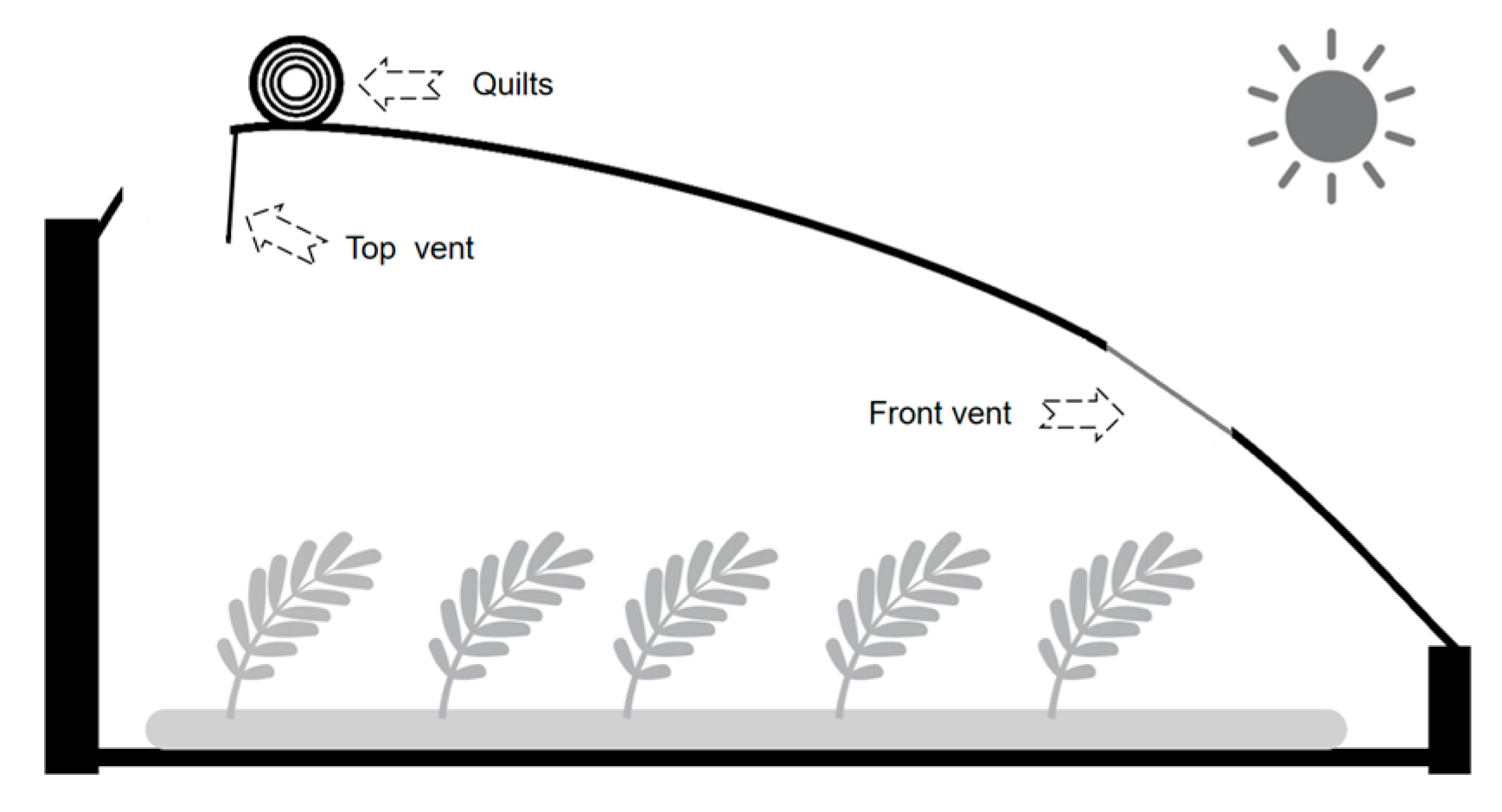
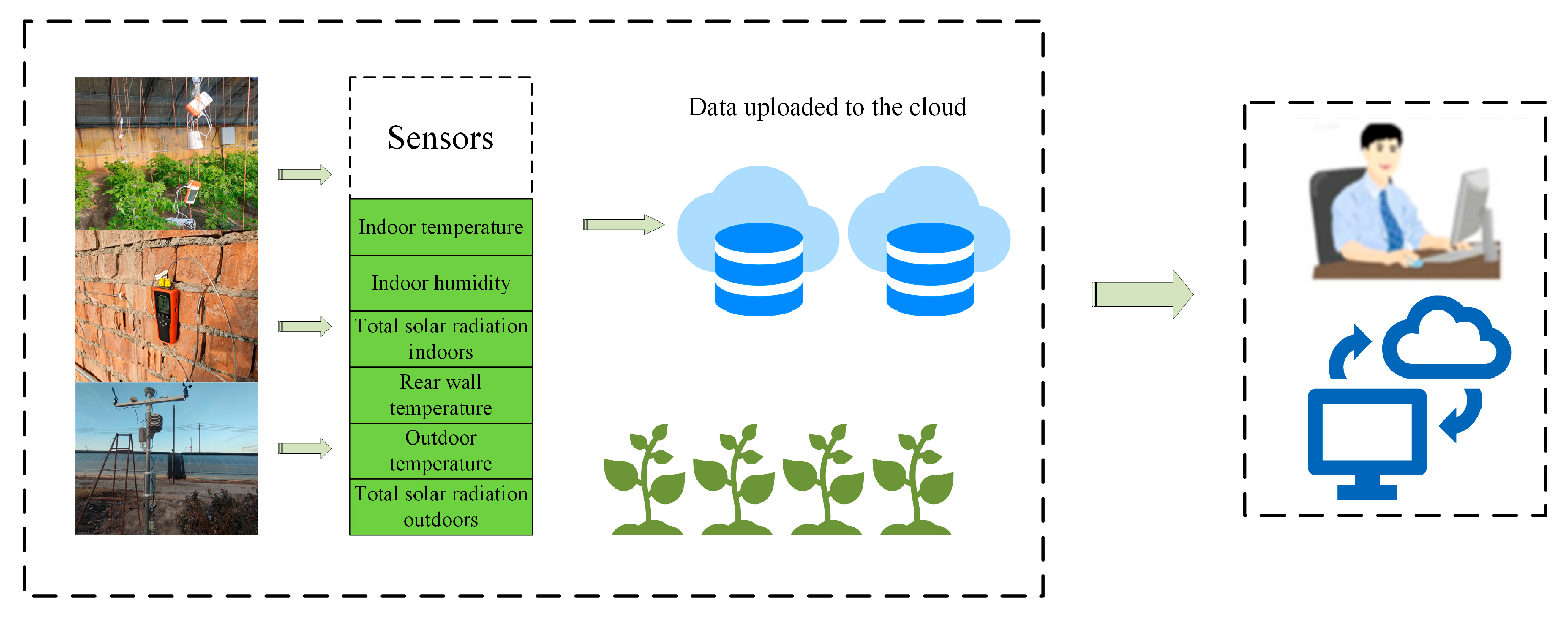

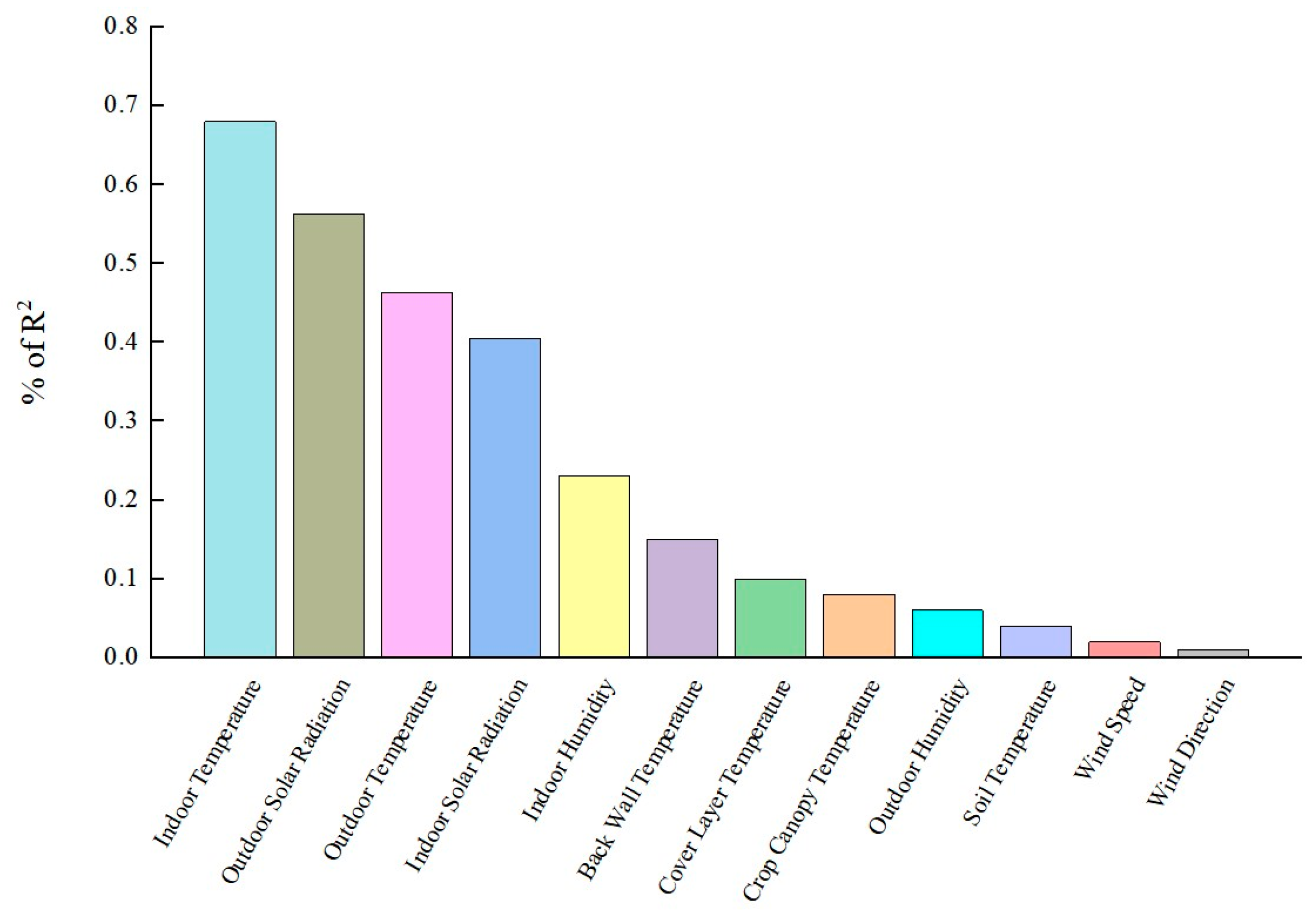

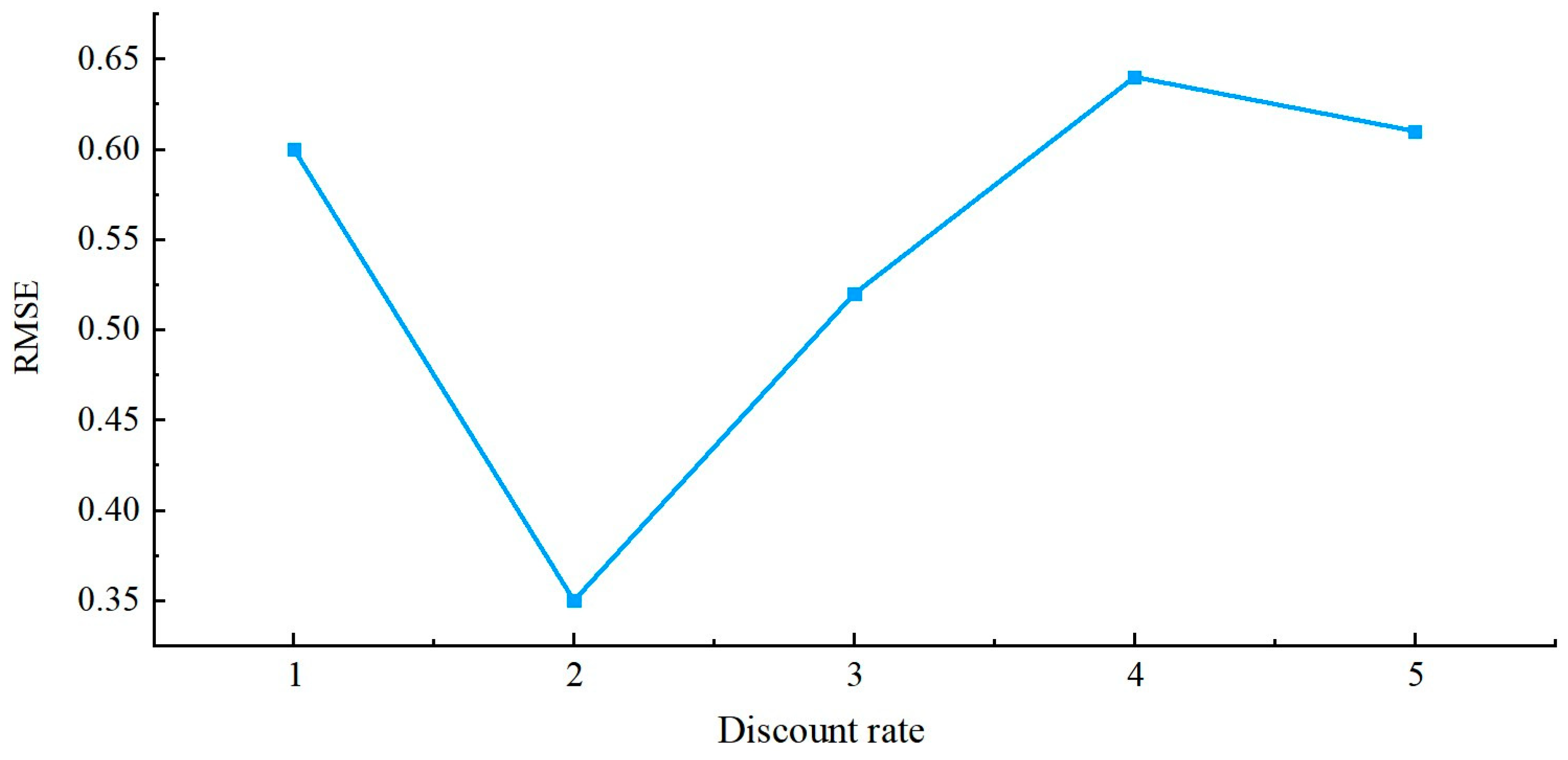
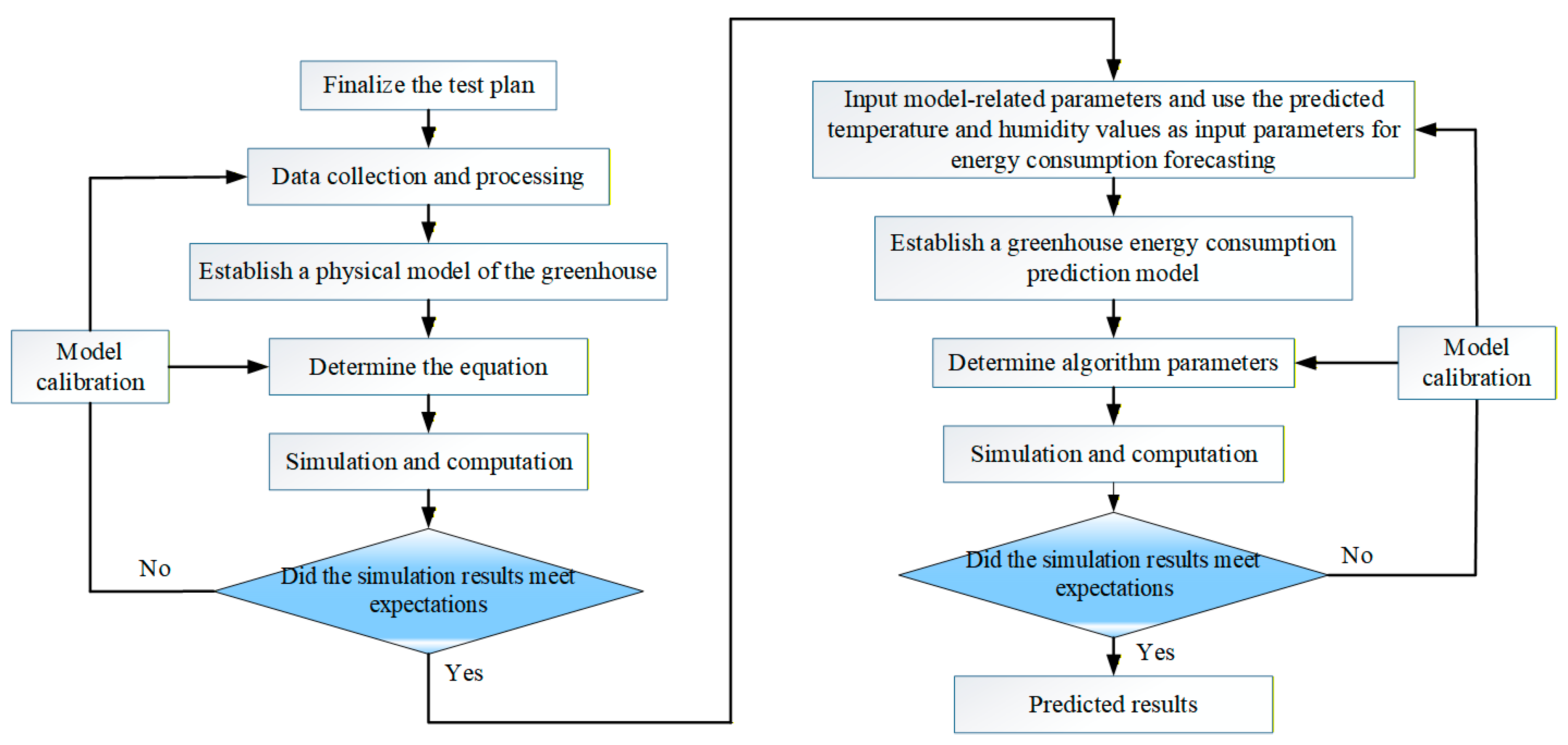



| Vegetable Crop | Daytime Temperature/°C | Temperature at Night/°C | |||
|---|---|---|---|---|---|
| Maximum | Desirable | Minimum | Desirable | Minimum | |
| tomato | 30 | 15~25 | 11 | 9~13 | 6 |
| Instruments/Tools | Model Number | Sensor Name | Measurement Range | Accurate | Resolution |
|---|---|---|---|---|---|
| PH automatic weather station (Wuhan Xinpuhui Technology Co., Ltd., Whuhan, China) | PH-CJ1 | Louvered box type temperature and humidity | Temperature: −50~+100 °C Humidity: 0~100%RH | Temperature: 0.1 °C Humidity: 0.1%RH | Temperature: ±0.5 °C Humidity: ±5% |
| PHWS wind speed | 0~45 m/s | 0.1 m/s | ±(0.3 ± 0.03 V)m/s | ||
| PHWDZ wind direction | 0~360° | 1° | ±3° | ||
| TBQ total radiation | 0~2000 W/m2 | 1 W/m2 | ±5% | ||
| PHZD Illumination | 0~200,000 lx | ±7% | |||
| Top Cloud-Agri portable wireless agro-meteorological remote detection system (Zhejiang Top Cloud-Agri Technology Co., Ltd., Hangzhou, China) | BNL-GPRS-10 G | Total solar radiation | 0~2000 W/m2 | ±1% | |
| Light intensity | 0~200,000 lx | ±1% | 1 lx | ||
| Jingchuang temperature and humidity recorder (Jiangsu Jingchuang Electronics Co., Ltd., Xuzhou, China) | GSP-6 | Temperature: −40~+85 °C Humidity: 10~99% RH | Temperature: ±0.3 °C Humidity: ±3% RH | Temperature: 0.1 °C Humidity: 0.1% | |
| Top Cloud-Agri wireless integrated agrometeorological monitoring stations (Zhejiang TOP Cloud-Agri Technology Co, Ltd., Hangzhou, China) | NL-GPRS-I | trident | Temperature: −50~+100 °C Humidity: 0~100% | Temperature: ±2% FS Humidity: ±2.5% | |
| Yuwen thermocouple temperature measuring instrument (Shenzhen Yuwen Precision Technology Co., Ltd., Shenzhen, China) | YET-620 dual channel | −200~+1370 °C | ±(3%|t| + 0.40) °C | 0.01 °C | |
| Top Cloud-Agri Plant canopy analyzer (Zhejiang Top Cloud-Agri Technology Co., Ltd., Hangzhou, China) | TOP-1300 | 0~2000 mol/m2∙S | |||
| T-Blade temperature (Urumqi Xivio Cryogenic Equipment Co., Ltd., Urumqi, China) | −40 °C~125 °C | ±0.5 °C | 0.0625 °C | ||
| Tape rule | 0–3 m | 0.1 mm |
| Parameter | Symbol | Value |
|---|---|---|
| Indoor air density | 1.16 kg/m3 | |
| Airborne heat content | 800 J/(kg·k) | |
| Greenhouse volume | 946 m3 | |
| Surface area of crop canopy | 100 m2 | |
| Surface area of rear wall | 85 m2 | |
| Soil surface area | 352 m2 | |
| Surface area of inner covering | 460 m2 | |
| Light transmission area of the inner covering | 315 m2 | |
| Mean wind cross sectional area | 132 m2 | |
| Heating system thermal effects | 0.85 | |
| Number of sunroof openings | 5 | |
| Sunroof length | 53 cm | |
| Sunroof width | 48 cm | |
| Crop extinction coefficient | 1.05 | |
| Leaf area index | 0.9 | |
| Gravitational acceleration | 9.8 m/s2 |
| Implicit Layer Node | Number of Iterations | Population Size | R2 | RMSE | MPE |
|---|---|---|---|---|---|
| 10 | 10 | 6 | 0.85 | 0.51 | 0.36 |
| 20 | 20 | 6 | 0.86 | 0.51 | 0.36 |
| 30 | 30 | 6 | 0.89 | 0.42 | 0.33 |
| 40 | 40 | 6 | 0.89 | 0.42 | 0.3 |
| 40 | 50 | 6 | 0.86 | 0.42 | 0.3 |
| 41 | 50 | 6 | 0.90 | 0.45 | 0.33 |
| 42 | 50 | 6 | 0.91 | 0.48 | 0.33 |
| 45 | 50 | 6 | 0.91 | 0.48 | 0.36 |
| 50 | 6 | 6 | 0.96 | 0.27 | 0.063 |
| Relevant Indicators | Overcast Sky | Clear Sky | |||||
|---|---|---|---|---|---|---|---|
| Relevant Model | RMSE | MPE | R2 | RMSE | MPE | R2 | |
| WOA-ELM | 0.423 | 0.252 | 0.93 | 0.27 | 0.063 | 0.96 | |
| BP | 0.585 | 0.444 | 0.85 | 0.705 | 0.477 | 0.89 | |
| RBF | 0.63 | 0.504 | 0.85 | 0.726 | 0.453 | 0.88 | |
| ELM | 0.573 | 0.348 | 0.88 | 0.639 | 0.339 | 0.91 | |
Disclaimer/Publisher’s Note: The statements, opinions and data contained in all publications are solely those of the individual author(s) and contributor(s) and not of MDPI and/or the editor(s). MDPI and/or the editor(s) disclaim responsibility for any injury to people or property resulting from any ideas, methods, instructions or products referred to in the content. |
© 2025 by the authors. Licensee MDPI, Basel, Switzerland. This article is an open access article distributed under the terms and conditions of the Creative Commons Attribution (CC BY) license (https://creativecommons.org/licenses/by/4.0/).
Share and Cite
Xie, C.; Dong, Y.; Liu, N.; Zhou, W.; Chu, J.; Tang, Y. Energy Consumption Prediction for Solar Greenhouse Based on Whale Optimization Extreme Learning Machine: Integration of Heat Balance Model and Intelligent Algorithm. AgriEngineering 2025, 7, 393. https://doi.org/10.3390/agriengineering7110393
Xie C, Dong Y, Liu N, Zhou W, Chu J, Tang Y. Energy Consumption Prediction for Solar Greenhouse Based on Whale Optimization Extreme Learning Machine: Integration of Heat Balance Model and Intelligent Algorithm. AgriEngineering. 2025; 7(11):393. https://doi.org/10.3390/agriengineering7110393
Chicago/Turabian StyleXie, Chang, Yuande Dong, Na Liu, Wei Zhou, Jinping Chu, and Yajie Tang. 2025. "Energy Consumption Prediction for Solar Greenhouse Based on Whale Optimization Extreme Learning Machine: Integration of Heat Balance Model and Intelligent Algorithm" AgriEngineering 7, no. 11: 393. https://doi.org/10.3390/agriengineering7110393
APA StyleXie, C., Dong, Y., Liu, N., Zhou, W., Chu, J., & Tang, Y. (2025). Energy Consumption Prediction for Solar Greenhouse Based on Whale Optimization Extreme Learning Machine: Integration of Heat Balance Model and Intelligent Algorithm. AgriEngineering, 7(11), 393. https://doi.org/10.3390/agriengineering7110393





